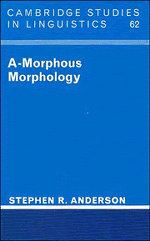Book contents
- Frontmatter
- Contents
- Acknowledgments
- Introduction
- 1 The study of word structure
- 2 Why have a morphology at all?
- 3 Is morphology really about morphemes?
- 4 The interaction of morphology and syntax
- 5 The theory of inflection
- 6 Some complex inflectional systems
- 7 Morphology in the lexicon: derivation
- 8 Clitics are phrasal affixes
- 9 The relation of morphology to phonology
- 10 How much structure do words have?
- 11 Composites: words with internal structure
- 12 Morphology and the typology of languages
- 13 Morphological change
- 14 Morphology as a computational problem
- References
- Index
1 - The study of word structure
Published online by Cambridge University Press: 10 January 2011
- Frontmatter
- Contents
- Acknowledgments
- Introduction
- 1 The study of word structure
- 2 Why have a morphology at all?
- 3 Is morphology really about morphemes?
- 4 The interaction of morphology and syntax
- 5 The theory of inflection
- 6 Some complex inflectional systems
- 7 Morphology in the lexicon: derivation
- 8 Clitics are phrasal affixes
- 9 The relation of morphology to phonology
- 10 How much structure do words have?
- 11 Composites: words with internal structure
- 12 Morphology and the typology of languages
- 13 Morphological change
- 14 Morphology as a computational problem
- References
- Index
Summary
The object of study in morphology is the structure of words, and the ways in which their structure reflects their relation to other words – relations both within some larger construction such as a sentence and across the total vocabulary of the language. Traditional grammars saw the study of words and their relations as absolutely central to an understanding of the workings of language. The analysis of word structure was, in fact, the context in which most of the problems we now call ‘syntax’ and ‘phonology’ arose, and as such it is probably no exaggeration to treat morphology as the foundation of traditional linguistics.
During the past 125 years or so, a concern for morphology has been particularly characteristic of the “mature” phase of various theoretical currents in the study of language. For example, the early excitement and sense of revolution associated with neogrammarian work (and more generally, with historical Indo-European studies) arose from novel ideas about phonological structure and change; but subsequent developments brought attention back to essentially morphological questions in the work of de Saussure, and later Hjelmslev, Kuryłowicz, and Benveniste; and it is arguable that the most active continuation of that paradigm (in the work of Calvert Watkins, the late Warren Cowgill, and their colleagues and students) focuses most clearly on morphology.
Similarly, synchronic structuralist theory (especially in the United States) began by dropping the question of word structure – indeed, denying that there was anything of interest to study there – and concentrating on phonology to the exclusion of all else.
- Type
- Chapter
- Information
- A-Morphous Morphology , pp. 7 - 21Publisher: Cambridge University PressPrint publication year: 1992



